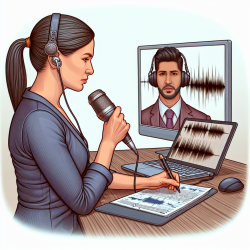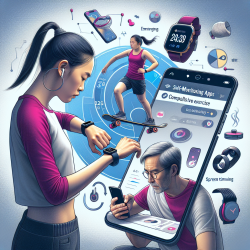In the evolving landscape of speech and language therapy (SLT), telepractice has become an indispensable tool, particularly highlighted during the recent global pandemic. The study "Comparison of In-Person and Online Recordings in the Clinical Teleassessment of Speech Production: A Pilot Study" provides valuable insights into the efficacy and reliability of teleassessment, particularly in evaluating motor speech disorders (MSD). Here, we explore how practitioners can leverage these findings to enhance their teleassessment practices.
Key Findings from the Study
The study compared three types of recordings:
- High-quality in-person recordings (HQ)
- Standard-quality in-person recordings (SQ)
- Online recordings via Zoom
Speech Rate Measures
The study found that several speech rate measures, such as the number of words per second when repeating the days of the week and the number of syllables per second in diadochokinetic (DDK) tasks, were reliably computed in both SQ and online recordings. This indicates that teleassessment can effectively measure speech rate, provided that high-quality recordings are used.
Voice Measures
Mean fundamental frequency (f0) was reliably computed in online sentence readings. However, other voice parameters, such as jitter, shimmer, and harmonic-to-noise ratio (HNR), required high-quality in-person recordings for accurate measurement. This highlights the need for professional-grade equipment when assessing voice quality remotely.
Perceptual Measures
Intelligibility and articulation measures showed significant discrepancies between online and in-person recordings. These perceptual differences were attributed to the distortion of the speech signal caused by online compression. Practitioners should be cautious not to over-diagnose based on online assessments alone and should consider conducting both in-person and online evaluations for a comprehensive understanding.
Maximal Phonation Time (MPT)
MPT was reliably measured in standard-quality in-person recordings but not in online recordings. This suggests that while teleassessment can be effective for some parameters, certain measures still require in-person evaluation to ensure accuracy.
Prosodic Contrast
Prosodic contrast was not reliably computed in online recordings but showed good reliability in standard-quality in-person recordings. This indicates that while some prosodic features can be assessed remotely, others still benefit from in-person evaluation.
Implications for Practitioners
Based on these findings, here are some actionable steps practitioners can take to improve their teleassessment practices:
- Use High-Quality Equipment: Invest in professional-grade microphones and recording devices to ensure the accuracy of voice and prosodic measures.
- Conduct Hybrid Assessments: Combine in-person and online assessments to get a comprehensive view of a client's speech production capabilities.
- Be Cautious with Perceptual Measures: Recognize the limitations of online recordings for perceptual measures like intelligibility and articulation, and avoid over-diagnosing based on these alone.
- Standardize Procedures: Follow standardized procedures for both in-person and online assessments to minimize variability and improve reliability.
- Continuous Training: Engage in continuous professional development to stay updated on the latest tools and techniques in teleassessment.
Encouraging Further Research
While this study provides a strong foundation, further research is needed to explore the long-term reliability of teleassessment across diverse populations and settings. Practitioners are encouraged to participate in or initiate studies that examine the efficacy of teleassessment tools and techniques, thereby contributing to the growing body of knowledge in this field.
Conclusion
Teleassessment offers a promising avenue for expanding access to speech therapy services, especially for individuals in remote locations. By understanding the strengths and limitations of teleassessment, practitioners can make informed decisions and provide high-quality care. For a deeper dive into the research, you can read the original research paper,
Comparison of In-Person and Online Recordings in the Clinical Teleassessment of Speech Production: A Pilot Study.










